Grafana
Grafana is an open-source visualization and analytics software that lets you query, alert on, and understand your metrics by turning time-series data into graphs and visualizations. This workflow lets you send actionable alerts to on-call resources when xMatters gets a signal from a Grafana unified alert. Responders can initiate an incident with the press of a button, or you can build on the flow to perform automated resolution tasks.
How it works
When a unified alert is generated in Grafana, it sends a JSON-formatted webhook to xMatters, based on user-defined alert rules. A Grafana trigger in xMatters parses the webhook and initiates a flow. The webhook includes essential alert data you can use to enrich notifications to users or when building automated tasks.
Install the workflow
The following instructions describe how to install the workflow through the xMatters one-click installation process. Instructions for the previous Grafana integration are available here.
- Go to the Workflow Templates page and click the Grafana tile.
- On the Set up the Workflow tab, give the workflow a name that identifies its purpose (this must be unique in your instance), add an optional description, and set the default incident type (if applicable). Any built-in Initiate Incident steps in the workflow will automatically be set to the selected incident type.
- You can edit these later, if needed.

- You can edit these later, if needed.
- Click Next to set up the connection.
- Choose the authentication method. A trigger URL is generated based on the selected authentication method.
- Copy the trigger URL — you’ll use this to configure the webhook in Grafana.
- The trigger URL includes the recipients parameter, which specifies who should be notified. By default, this parameter is set to notify you (the logged in user), but you can set it to target any user or group you want.
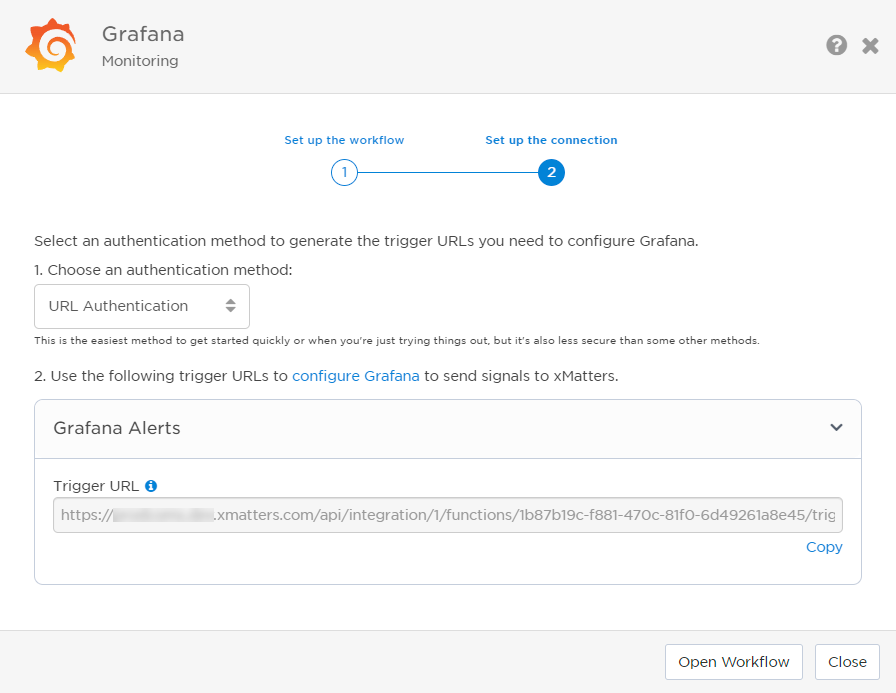
- The trigger URL includes the recipients parameter, which specifies who should be notified. By default, this parameter is set to notify you (the logged in user), but you can set it to target any user or group you want.
- Click Open Workflow to view and customize the workflow, or Close to return to the Workflows page.
Configure Grafana to send requests to the trigger URL
To have Grafana send alerts to the flow trigger, you need to configure a Contact Point webhook and set it to use the trigger URL.
- In Grafana, go to Alerting and select the Contact Point tab.
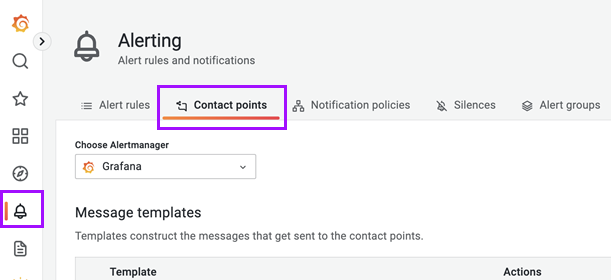
- In the Contact points section of the page, click New contact point.
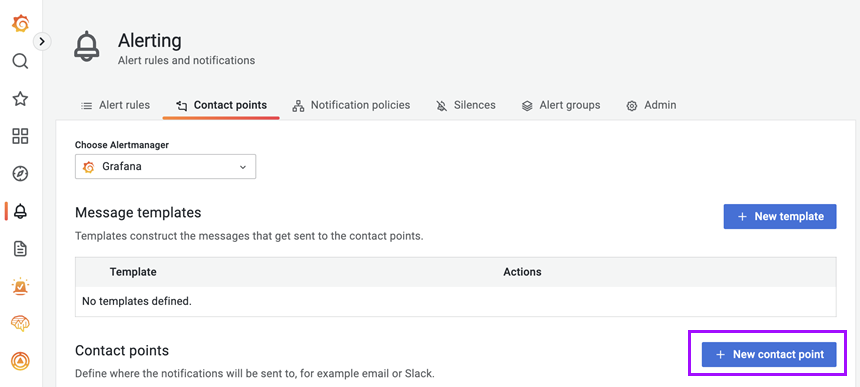
- On the Create contact point screen, fill in the following fields:
- Name: xMatters
- Contact point type: Select Webhook from the drop-down menu of options.
- URL: Paste the trigger URL you copied from Flow Designer.

- Add the target names of any recipients you want to notify when the alert fires.
- For URL authentication, use an ampersand to attach recipients. For example, if you want to notify Emma Pearson and the on-call members in the group responsible for the Antares service, you'd add &recipients=epearson,antares to the end of the URL.
- For other authentication types, use a question mark to attach recipients. For example, if you want to notify Barry Gull and the on-call members in the group responsible for the Cassiopeia service, you'd add ?recipients=bgull,cassiopeia to the end of the URL.
- You must URL-encode any special characters or spaces in the target names.
- Optional: If you choose to use Basic Authentication, expand the Optional Webhook settings menu to enter your Username and Password.
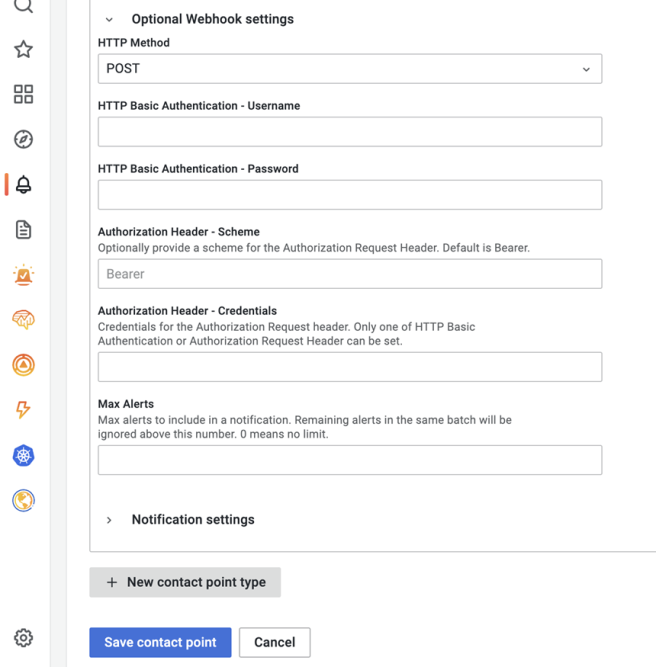
- Click Save contact point.
- Add this notification channel to any alert rules you'd like to connect with xMatters.
You're ready to use the webhook to trigger automated flows, including steps such as sending alerts and initiating incidents, though we always recommend testing before putting things into use.
Set recipients in the trigger URL
The trigger expects the recipients in the trigger URL. When you copy the URL from xMatters, it includes the recipients parameter: recipients=<yourname>. Of course, you don’t want to receive all the alerts.
To change the recipients for alerts from this webhook, swap out your name for the people or groups you want to target.
- For URL authentication, use an ampersand to attach recipients. For example, if you want to notify Emma Pearson and the on-call members in the group responsible for the Antares service, you'd add &recipients=epearson,antares to the URL.
- For other authentication types, use a question mark to attach recipients. For example, if you want to notify Barry Gull and the on-call members in the group responsible for the Cassiopeia service, you'd add ?recipients=bgull,cassiopeia to the URL.
Remember to URL-encode any special characters, including spaces, in your group names.
We recommend using groups so you can take advantage of the xMatters group features — rotations, escalations, and absences — to reach the right on-call people to jump on an issue.
How to use the workflow
When a condition you've set fires, it sends a signal to xMatters, which creates an alert and notifies the individual or the on-call members of the people or groups you set as recipients in the webhook URL. When the trigger receives a signal saying the issue is resolved, it automatically terminates related alerts in xMatters.
The person responding to the notification has the following response options:
- Acknowledge: Acknowledges the notifications and stops escalations.
- Escalate: Immediately escalates the alert to the next on-call resolver in a targeted group.
- Close: Ends the xMatters alert and stops notifying all targeted recipients.
- Initiate Incident: Initiates an incident in xMatters.
Next Steps
Now that you've installed the workflow, you can use it as-is, or customize it to suit your needs better. Here are some examples of things you can add to the workflow to customize it:
- Use Slack, Zoom, and Microsoft Teams steps to add collaboration channels to the flow.
- Change the severity of incidents created when a recipient selects the Initiate Incident response.
- Update the message sent to resolvers to include the information most relevant to your team.
- Use the Grafana Alerts trigger to build your own custom flows.
Previous versions
The instructions for the previous version of Grafana are included here for anyone who has it installed in their system already.
Grafana is an open-source visualization and analytics software that lets you query, alert on, and understand your metrics by turning time-series data into graphs and visualizations. This workflow lets you send actionable alerts to on-call resources when xMatters gets a signal from Grafana. Responders can initiate an incident with the press of a button, or you can build on the flow to perform automated resolution tasks.
How it works
When an alert is generated in Grafana, it sends a JSON-formatted webhook to xMatters, based on user-defined alert rules. A Grafana trigger in xMatters parses the webhook and initiates a flow. The webhook includes essential alert data you can use to enrich notifications to users or when building automated tasks.
Install the workflow
The following instructions describe how to install the workflow through the xMatters one-click installation process.
- Download the workflow from the Downloads site and save it to an easy to find location on your computer.
- Go to Workflows > Workflows.
- Click Import.
- On the Import Workflow window, navigate to the location where you saved the Grafana zip file.
- Click Import.
- Click Open Workflow.
The workflow import and installation is complete.
- Go to the Flow Designer tab and double-click Grafana Alerts to open the workflow.
- Double-click the Grafana Alerts trigge.
- On the Settings screen, choose the authentication method and Authenticating User. A trigger URL is generated based on the selected authentication method.
- Copy the trigger URL — you’ll use this to configure the webhook in Grafana.
- The trigger URL includes the recipients parameter, which specifies who should be notified. By default, this parameter is set to notify you (the logged in user), but you can set it to target any user or group you want.
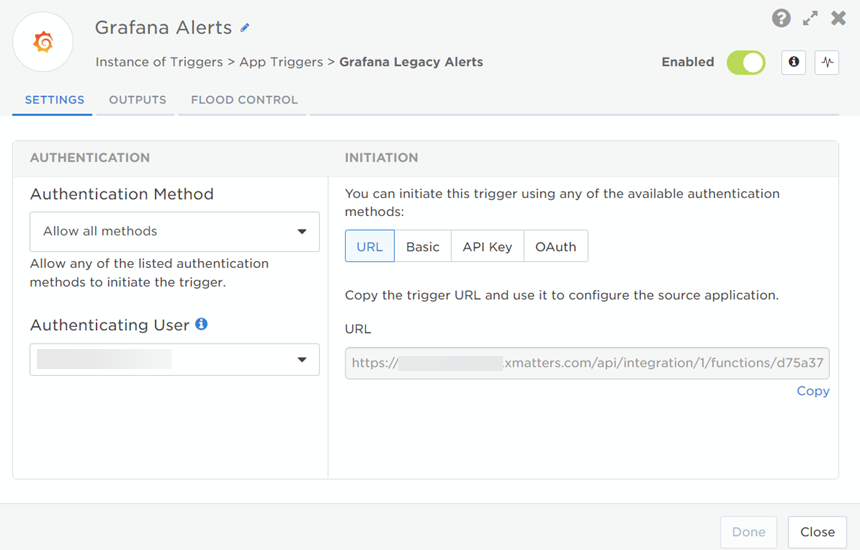
- The trigger URL includes the recipients parameter, which specifies who should be notified. By default, this parameter is set to notify you (the logged in user), but you can set it to target any user or group you want.
- If you changed the authentication method click Done to save the changes. Otherwise, click Close to return to the canvas.
You're now ready to configure Grafana.
Configure Grafana to send requests to the trigger URL
To have Grafana send alerts to the flow trigger, you need to configure a webhook and set it to use the trigger URL.
- In Grafana, go to Alerting > Notification channels.
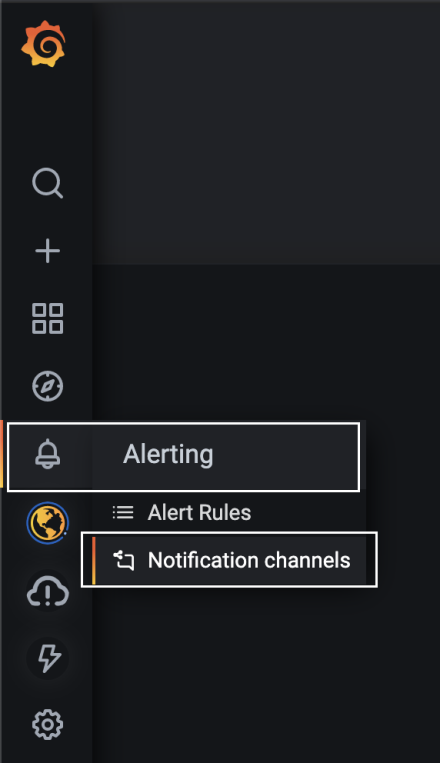
- Create a new Notification channel and fill in the following fields:
- Name: xMatters
- Type: Webhook
- Url: Paste the trigger URL you copied previously.
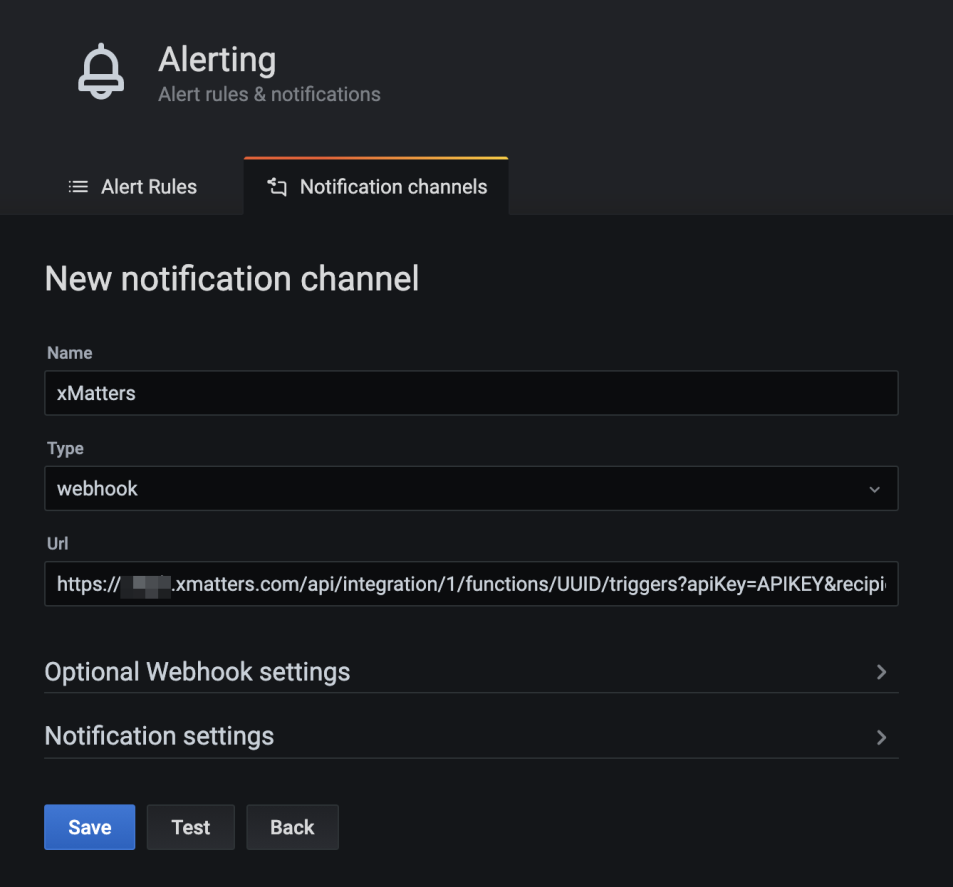
- Add the target names of any recipients you want to notify when the alert fires.
- For URL authentication, use an ampersand to attach recipients. For example, if you want to notify Emma Pearson and the on-call members in the group responsible for the Antares service, you'd add &recipients=epearson,antares to the end of the URL.
- For other authentication types, use a question mark to attach recipients. For example, if you want to notify Barry Gull and the on-call members in the group responsible for the Cassiopeia service, you'd add ?recipients=bgull,cassiopeia to the end of the URL.
- You must URL-encode any special characters or spaces in the target names.
- Optional: If you choose to use Basic Authentication, expand the Optional Webhook settings menu to enter your Username and Password.
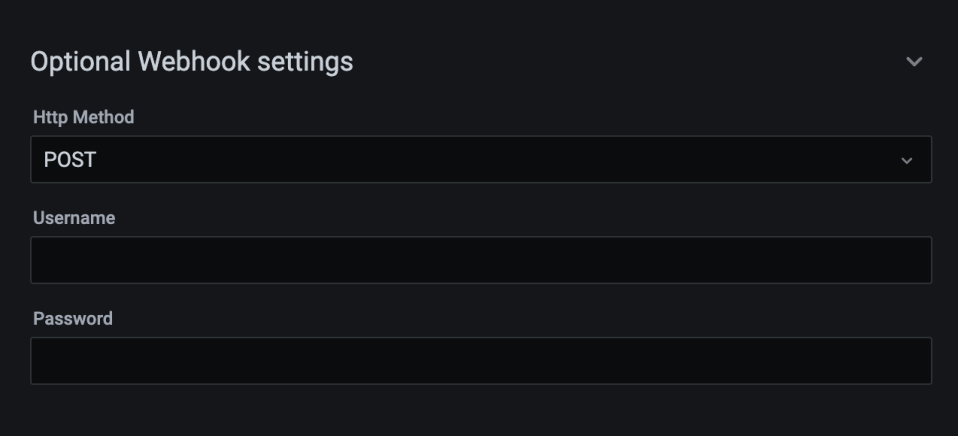
- Click Save.
- Add this notification channel to any alert rules you'd like to connect with xMatters.
You're ready to use the webhook to trigger automated flows, including steps such as sending alerts and initiating incidents, though we always recommend testing before putting things into use.
Set recipients in the trigger URL
The trigger expects the recipients in the trigger URL. When you copy the URL from xMatters, it includes the recipients parameter: recipients=<yourname>. Of course, you don’t want to receive all the alerts.
To change the recipients for alerts from this webhook, swap out your name for the people or groups you want to target.
- For URL authentication, use an ampersand to attach recipients. For example, if you want to notify Emma Pearson and the on-call members in the group responsible for the Antares service, you'd add &recipients=epearson,antares to the URL.
- For other authentication types, use a question mark to attach recipients. For example, if you want to notify Barry Gull and the on-call members in the group responsible for the Cassiopeia service, you'd add ?recipients=bgull,cassiopeia to the URL.
Remember to URL-encode any special characters, including spaces, in your group names.
We recommend using groups so you can take advantage of the xMatters group features — rotations, escalations, and absences — to reach the right on-call people to jump on an issue.
How to use the workflow
When a condition you've set fires, it sends a signal to xMatters, which creates an alert and notifies the individual or the on-call members of the people or groups you set as recipients in the webhook URL. When the trigger receives a signal saying the issue is resolved, it automatically terminates related alerts in xMatters.
The person responding to the notification has the following response options:
- Acknowledge: Acknowledges the notifications and stops escalations.
- Escalate: Immediately escalates the alert to the next on-call resolver in a targeted group.
- Close: Ends the xMatters alert and stops notifying all targeted recipients.
- Initiate Incident: Initiates an incident in xMatters.
Next Steps
Now that you've installed the workflow, you can use it as-is, or customize it to suit your needs better. Here are some examples of things you can add to the workflow to customize it:
- Use Slack, Zoom, and Microsoft Teams steps to add collaboration channels to the flow.
- Change the severity of incidents created when a recipient selects the Initiate Incident response.
- Update the message sent to resolvers to include the information most relevant to your team.
- Use the Grafana Legacy Alerts trigger to build your own custom flows.
